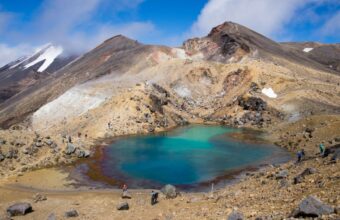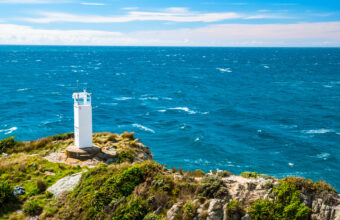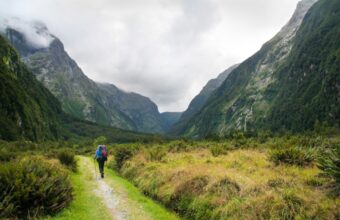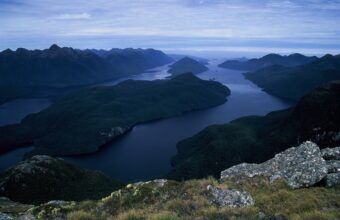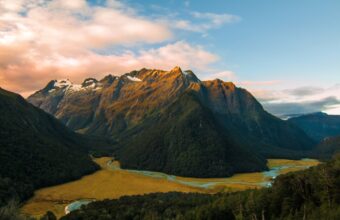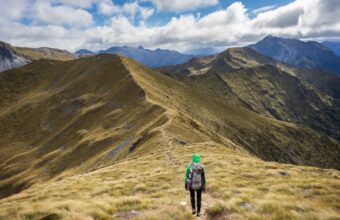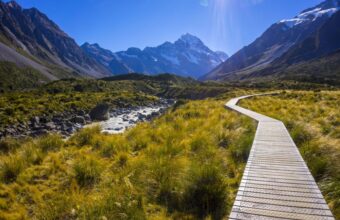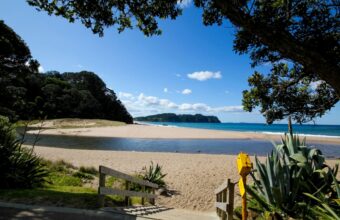Hiking In New Zealand
The best walking holidays in New Zealand
New Zealand is a hiker’s paradise, and its stunningly beautiful landscapes are mind-boggling in their diversity – from soaring peaks and glaciers to fern-carpeted forests, rolling grasslands, smouldering volcanoes and an exquisite coastline.
From the first time I set foot on a New Zealand hiking trail and began trekking into its wild places and national parks, I was hooked.
Hiking (or tramping as it’s known locally) in New Zealand is much closer to a genuine wilderness experience than hiking in Europe – not only are the routes are often remote, but the landscapes are wonderfully free from most of the clutter which otherwise goes into turning a mountain into a popular and accessible hiking area.
In the New Zealand backcountry you won’t pass convenient shops or villages to buy supplies – or pretty much anything man made for that matter. Other than a succession of excellent mountain huts, footbridges on some (though not all) of the river crossings, and a few trail markings, you’re on your own.
But there’s a good chance you’ll encounter an extraordinary variety of wildlife, and the scenery will be sublime, the silence immense. This is hiking in the raw, through landscapes which are magnificently wild and unspoilt.
Where to go hiking in New Zealand
Our experts' top picks

Tongariro National Park
Tongariro National Park
New Zealand’s oldest national park is also a UNESCO World Heritage area, noted for both its cultural and natural significance.
With three active volcanoes — Tongariro, Ngauruhoe, and Ruapehu — the high plateau of the Tongariro National Park offers challenging hikes. The Tongariro Alpine Crossing day hike is very popular, but the longer (3-4 day) Tongariro Northern Circuit is an alternative for experienced trekkers. It’s best to go with a guide, as conditions can change rapidly in the alpine landscape.

Abel Tasman National Park
Abel Tasman National Park
Abel Tasman’s compact size makes it an easy place for trips to beautiful beaches, day hikes, longer treks, boat rides along the coast, and kayaking excursions.
While the five-day Coastal Track is the most famous walk, shorter sections can be done with the help of water taxi transfers, and the Inland Track sees far fewer hikers.

Fiordland
Fiordland National Park
Although Milford Sound is one of the South Island’s most popular attractions, the large Fiordland National Park it sits within contains huge expanses of wilderness.
Long-distance treks – including the most famous Milford Track – lead through some of the 14 fiords reveal waterfalls, fur seals, penguins, dolphins, and watery mountain vistas—but don’t forget the wet-weather gear.

Milford Sound
Even by New Zealand’s standards, Milford Sound is a truly spectacular sight. Located in the southwest of the South Island, the beautiful fjord is packed with jaw-droppingly beautiful natural features, including Mitre Peak, rainforests and stunning waterfalls, such as Stirling and Bowen Falls.

Coromandel Peninsula
Coromandel Peninsula
Visible across the Hauraki Gulf from Auckland, the Coromandel Peninsula has some of the most famous beaches in the country, but is also a hiking paradise.
The centre of the peninsula is covered in forested hills and thick rainforest. The Pinnacles Walk in the Coromandel Forest Park is a highlight, and can be done as a one-day or overnight hike. The summit of the Pinnacles is at 758m and has great views of the forest and peninsula. Some parts are very steep.
The best hikes and walking holidays in New Zealand
Some of the most popular – and lesser known – treks
If you pushed me to pick a top favourite, it would probably be the Tongariro Northern Circuit. But all the following are well worth your time.
-
Tongariro National Park
-
Abel Tasman National Park
-
Fiordland
-
Fiordland
-
Fiordland
-
Fiordland
-
Rangitoto Island
-
Aoraki Mount Cook National Park
-
Coromandel Peninsula
View trips
Planning a New Zealand hiking holiday
Everything you wish you'd known before you booked
Great walks beyond the ‘Great Walks’
Do a search for New Zealand walking holidays and you’ll be confronted with page after page of the famous Great Walks; ten long-distance, waymarked paths in some of the country’s most iconic locations across North, South and Stewart Islands. As is all-too-often the case with tourism marketing, the Great Walks campaign has become something of a victim of its own success, and demand for the tracks has grown far beyond what they can comfortably accommodate without sacrificing their wilderness appeal.
As a result, the Department of Conservation has had to come up with ways to limit the numbers of hikers on the trails. First up was a mandatory booking system – on which places for the most popular trails such as the Milford Track can sell out in minutes – followed by regular price increases.
If you’re adamant about doing a Great Walk, plan ahead and get on the official booking site well before they go on sale.
But my main advice is to look beyond the Great Walks, as there are infinitely more tracks, all of which are deserving of the title ‘great’ but see far fewer hikers. Good multi-day alternatives that I’d recommend include the Dusky Sound Track, the Hollyford Track or the Abel Tasman Inland Track, but there are countless others.
New Zealand hiking FAQs
Your questions, our expert answers
Question
When is the best time to go hiking in New Zealand?
Answer
The hiking season in New Zealand runs from November to April, with December to February being the peak summer months – the weather will be at its warmest and most stable during this time, and trails will be at their busiest. Booking is required on the Great Walks from November to April, and you can expect huts on the most popular routes to get fully booked.
Remember the weather in New Zealand’s mountains can be glorious, but it’s also notoriously fickle – don’t go hiking without appropriate warm and waterproof clothing. I made that mistake once, back in the early days – and have never done it again.
Question
Can you trek in New Zealand in the low season?
Answer
Low season hiking is possible in some low-lying areas, but on higher routes there will be significant amounts of snow, making some trails impassable, with the risk of avalanches. Hut bookings are not required in the low season.
Question
Can you personally recommend your favourite New Zealand hike?
Answer
There are a lot of walks in New Zealand which I absolutely love, both multi-day treks and shorter one-day hikes. However if I had to pick a favourite it would be the Tongariro Northern Circuit – the volcanic scenery is just out of this world. It was the first big trek I did in New Zealand (or anywhere) with whopping great mountains as opposed to hills, many many years ago. It’s one of the places I really fell under the spell of the great outdoors.
Question
How do the mountain huts work?
Answer
New Zealand has an excellent network of mountain huts, providing overnight shelter on its amazing hiking routes. These are not like huts in the Alps however where you can order a three course meal – you need to carry all your own food, and a stove to cook it with, along with a sleeping bag. Booking is required at huts on the more popular routes during the hiking season, and often places sell out many months in advance.
Question
What gear should I take on a multi-day trek in New Zealand?
Answer
Along with a good rucksack, hiking boots and suitable warm and waterproof layers of clothing, sleeping bag, stove and fuel, first aid kit, torch, map and compass, and a reflective ‘space blanket’ in case of emergencies – I always take a pair of rafting sandals (to wear in the evening, and for river crossings) and a water filter. Hiking poles are invaluable. Add a reliable tent plus sleeping mat if you’re camping. You can’t buy food or supplies along the way on most New Zealand hiking routes, so you’ll need to carry enough food to last for however many days you plan to be on the trail (plus at least one day extra in case of emergencies).

